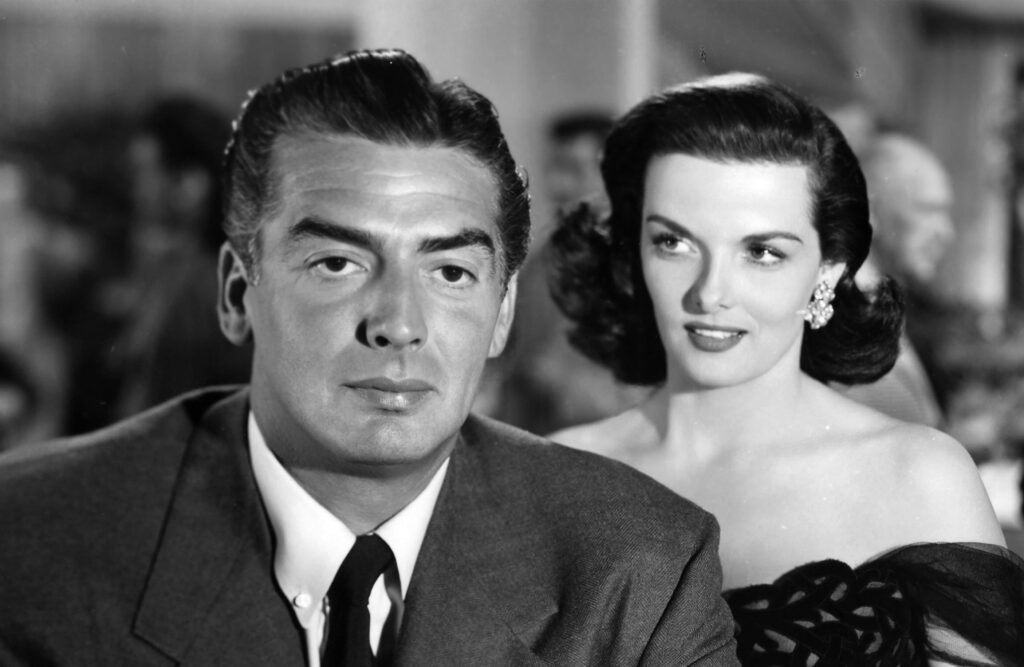Classic Film: The Las Vegas Story
Written by Ian Thomas Malone, Posted in Blog, Movie Reviews, Pop Culture
Many have seen Las Vegas as a place of opportunity, only to leave town feeling like a loser. Vegas isn’t for everyone. It takes a certain kind of person to thrive in such a high-stakes, cut-throat environment. 1952’s The Las Vegas Story explores the kinds of characters who would try their luck there and the unfortunate suckers who would be better off steering clear of Sin City.
Linda Rollins (Jane Russell) used to thrive as a singer in Vegas before leaving town, much to the chagrin of her old performing partner, Happy (Hoagy Carmichael), who plays piano at the Last Chance Casino. Linda returns to town at the behest of her husband, Lloyd (Vincent Price), desperate to make a quick buck. While in town, Linda reconnects with her old fling Dave Andrews (Victor Mature), a local police lieutenant, sparking memories of what might have been if she’d settled down with a better man.
Director Robert Stevenson sends his narrative in about a million different directions. The drama of Lloyd’s money troubles becomes exacerbated by a murder about halfway through the narrative, an audible that shifts the film’s focus from character drama to a rather conventional whodunit. The story’s bread and butter is the relationship between Linda and Dave, enhanced by the great chemistry between Russell and Mature.
The film’s unfocused narrative is buoyed by a deep bench of compelling characters, led by Russell’s commanding lead performance. Linda didn’t want to return to Vegas, but quickly rekindles the magic in the place where she used to thrive. The film often offers meditations on the passing of time, refreshingly upbeat despite its noir genre trappings.
While the pulpier murder mystery intrigue cuts some of the character drama short, the tonal shift gives way to one of the earliest helicopter/car chases in film, a highly impressive feat of cinematography. Russell is unmatched by her male counterparts, but Mature brings a great deal of depth to Dave, refusing to let the character be put into a box as a jealous ex-boyfriend.
Linda possesses a level of complexity rarely afforded to female characters in the time period. Her relationships with her husband and former lover aren’t pitted against each other in the way the audience might expect, instead reflecting the intricate complexity of human emotion that isn’t easily boxed into a love triangle. Russell is given so much space to explore Linda’s motivations, quite impressive given everything else going on in the film.
What works best about The Las Vegas Story is the way this world feels lived in. The characters carry their decades of baggage while striving toward a better future. Vegas’ unforgiving atmosphere isn’t for everyone, but few films so eloquently depict the appeal of the city for those tough enough to thrive there. If you can make it in Vegas, could you be happy anywhere else?
Stevenson’s final credited RKO picture may not exactly be a triumph of filmmaking beyond its groundbreaking helicopter chase, but The Las Vegas Story is the kind of narrative that sticks with you long after the credits have rolled. A mid-movie musical number from Carmichael’s Happy perhaps illustrates this dynamic best, an out-of-place sequence that hits home through its sheer delight. Like the jazz Carmichael so excelled at, the film knows how to sequence itself in a way that feels both spontaneous and carefully choreographed in its delivery.
The various pieces of the film don’t necessarily connect in a way that crafts the most cohesive experience, but there’s so much to enjoy along the way. Fine art is rarely produced by throwing everything at the wall to see what sticks. The Las Vegas Story feels like Stevenson managed to stick most of what he’d thrown, a real treat of a B movie well worth the ninety-minute runtime.











